Design-Build Project Delivery vs Traditional Procurement Methods
VerifiedAdded on 2023/06/13
|122
|38376
|338
Report
AI Summary
This report provides an overview of innovative project delivery methods for infrastructure, with an international perspective, focusing on the road sector. It contrasts traditional Design-Bid-Build methods with more progressive approaches like Design-Build (DB), Design-Build Operate Maintain (DBOM), and Design-Build Finance Operate (DBFO). The study, incorporating data from countries like Australia, Canada, England, Finland, New Zealand, Sweden, and the USA, highlights the advantages and disadvantages of various maintenance contract types, including traditional, hybrid, long-term, and Performance Specified Maintenance Contracts (PSMC). The report emphasizes the importance of partnering, lump sum contracts, and quality-based contractor selection for maximizing innovation in infrastructure projects. It concludes that adopting innovative methods requires a paradigm shift but is essential for keeping pace with societal changes and improving infrastructure management.
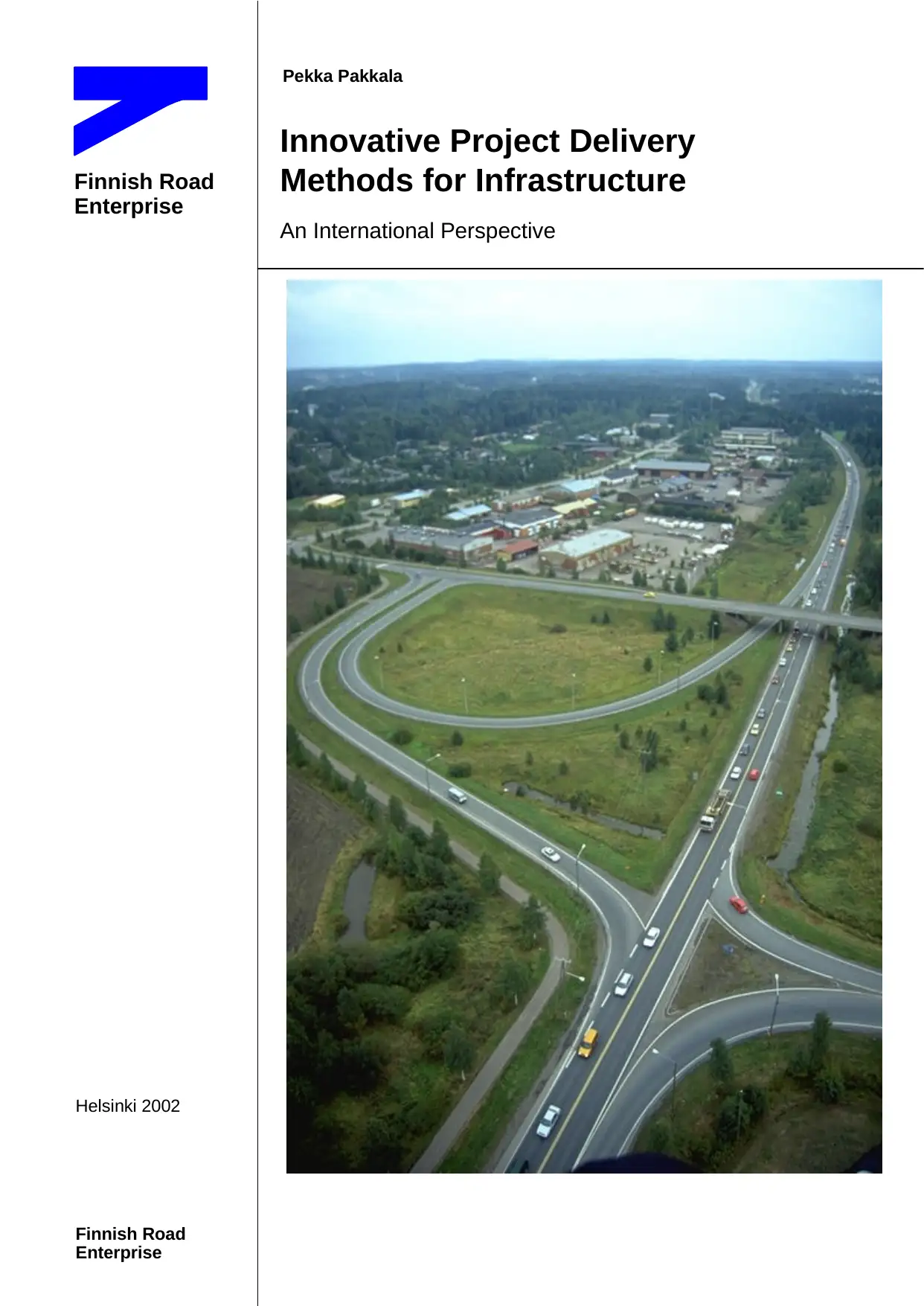
Pekka Pakkala
Finnish Road
Enterprise
Helsinki 2002
Finnish Road
Enterprise
Innovative Project Delivery
Methods for Infrastructure
An International Perspective
Finnish Road
Enterprise
Helsinki 2002
Finnish Road
Enterprise
Innovative Project Delivery
Methods for Infrastructure
An International Perspective
Paraphrase This Document
Need a fresh take? Get an instant paraphrase of this document with our AI Paraphraser

Pekka Pakkala
Innovative Project Delivery Methods for
Infrastructure
An International Perspective
Finnish Road Enterprise
Headquarters
Helsinki 2002
Innovative Project Delivery Methods for
Infrastructure
An International Perspective
Finnish Road Enterprise
Headquarters
Helsinki 2002

Cover: Tapio Kalliomäki
ISBN 952-5408-05-1
Oy Edita Ab
Helsinki 2002
Finnish Road Enterprise
Opastinsilta 12 B
P.O.Box 73
FIN-00521 HELSINKI
Tel. + 358 20 444 11
ISBN 952-5408-05-1
Oy Edita Ab
Helsinki 2002
Finnish Road Enterprise
Opastinsilta 12 B
P.O.Box 73
FIN-00521 HELSINKI
Tel. + 358 20 444 11
⊘ This is a preview!⊘
Do you want full access?
Subscribe today to unlock all pages.

Trusted by 1+ million students worldwide
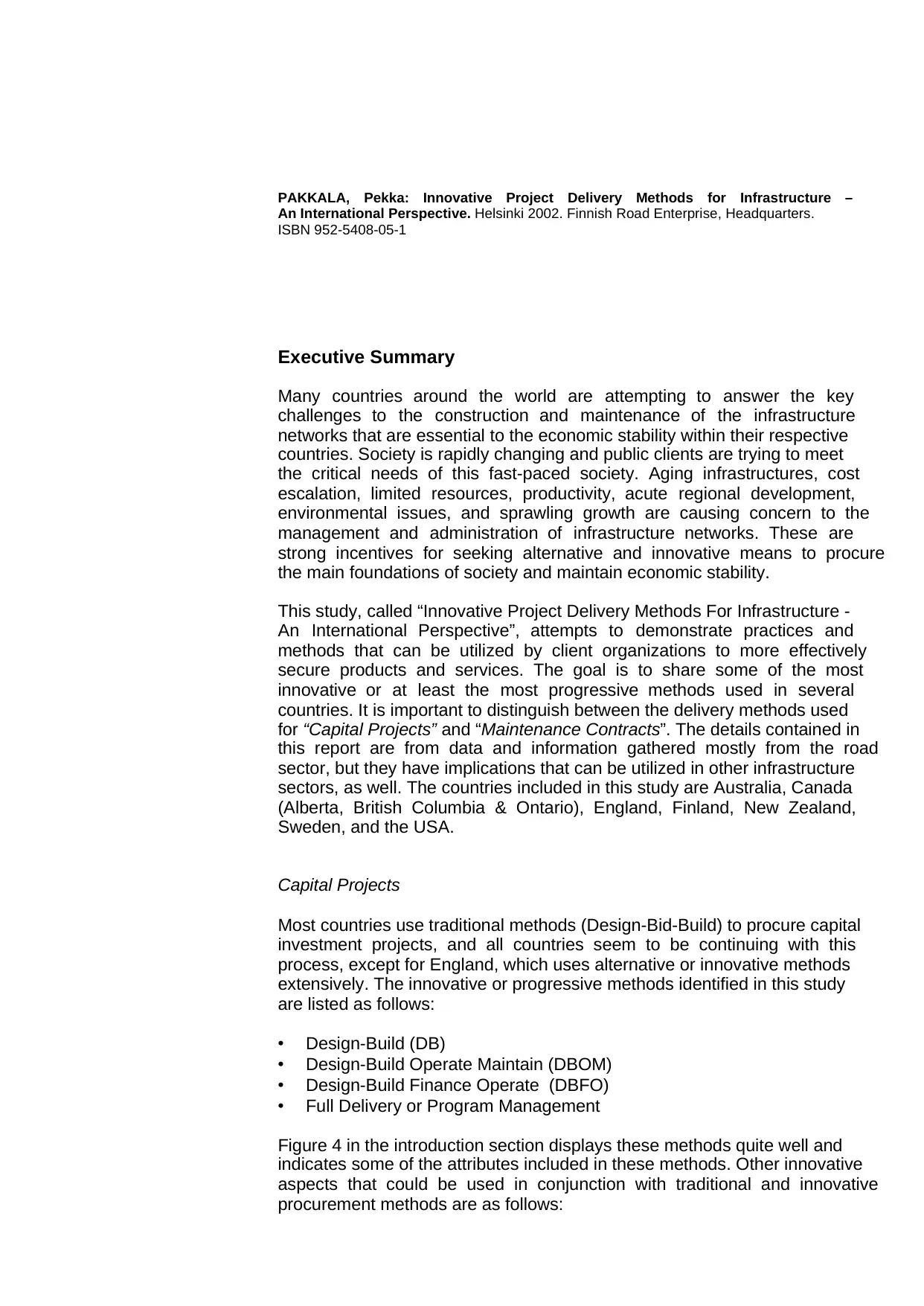
PAKKALA, Pekka: Innovative Project Delivery Methods for Infrastructure –
An International Perspective. Helsinki 2002. Finnish Road Enterprise, Headquarters.
ISBN 952-5408-05-1
Executive Summary
Many countries around the world are attempting to answer the key
challenges to the construction and maintenance of the infrastructure
networks that are essential to the economic stability within their respective
countries. Society is rapidly changing and public clients are trying to meet
the critical needs of this fast-paced society. Aging infrastructures, cost
escalation, limited resources, productivity, acute regional development,
environmental issues, and sprawling growth are causing concern to the
management and administration of infrastructure networks. These are
strong incentives for seeking alternative and innovative means to procure
the main foundations of society and maintain economic stability.
This study, called “Innovative Project Delivery Methods For Infrastructure -
An International Perspective”, attempts to demonstrate practices and
methods that can be utilized by client organizations to more effectively
secure products and services. The goal is to share some of the most
innovative or at least the most progressive methods used in several
countries. It is important to distinguish between the delivery methods used
for “Capital Projects” and “Maintenance Contracts”. The details contained in
this report are from data and information gathered mostly from the road
sector, but they have implications that can be utilized in other infrastructure
sectors, as well. The countries included in this study are Australia, Canada
(Alberta, British Columbia & Ontario), England, Finland, New Zealand,
Sweden, and the USA.
Capital Projects
Most countries use traditional methods (Design-Bid-Build) to procure capital
investment projects, and all countries seem to be continuing with this
process, except for England, which uses alternative or innovative methods
extensively. The innovative or progressive methods identified in this study
are listed as follows:
• Design-Build (DB)
• Design-Build Operate Maintain (DBOM)
• Design-Build Finance Operate (DBFO)
• Full Delivery or Program Management
Figure 4 in the introduction section displays these methods quite well and
indicates some of the attributes included in these methods. Other innovative
aspects that could be used in conjunction with traditional and innovative
procurement methods are as follows:
An International Perspective. Helsinki 2002. Finnish Road Enterprise, Headquarters.
ISBN 952-5408-05-1
Executive Summary
Many countries around the world are attempting to answer the key
challenges to the construction and maintenance of the infrastructure
networks that are essential to the economic stability within their respective
countries. Society is rapidly changing and public clients are trying to meet
the critical needs of this fast-paced society. Aging infrastructures, cost
escalation, limited resources, productivity, acute regional development,
environmental issues, and sprawling growth are causing concern to the
management and administration of infrastructure networks. These are
strong incentives for seeking alternative and innovative means to procure
the main foundations of society and maintain economic stability.
This study, called “Innovative Project Delivery Methods For Infrastructure -
An International Perspective”, attempts to demonstrate practices and
methods that can be utilized by client organizations to more effectively
secure products and services. The goal is to share some of the most
innovative or at least the most progressive methods used in several
countries. It is important to distinguish between the delivery methods used
for “Capital Projects” and “Maintenance Contracts”. The details contained in
this report are from data and information gathered mostly from the road
sector, but they have implications that can be utilized in other infrastructure
sectors, as well. The countries included in this study are Australia, Canada
(Alberta, British Columbia & Ontario), England, Finland, New Zealand,
Sweden, and the USA.
Capital Projects
Most countries use traditional methods (Design-Bid-Build) to procure capital
investment projects, and all countries seem to be continuing with this
process, except for England, which uses alternative or innovative methods
extensively. The innovative or progressive methods identified in this study
are listed as follows:
• Design-Build (DB)
• Design-Build Operate Maintain (DBOM)
• Design-Build Finance Operate (DBFO)
• Full Delivery or Program Management
Figure 4 in the introduction section displays these methods quite well and
indicates some of the attributes included in these methods. Other innovative
aspects that could be used in conjunction with traditional and innovative
procurement methods are as follows:
Paraphrase This Document
Need a fresh take? Get an instant paraphrase of this document with our AI Paraphraser
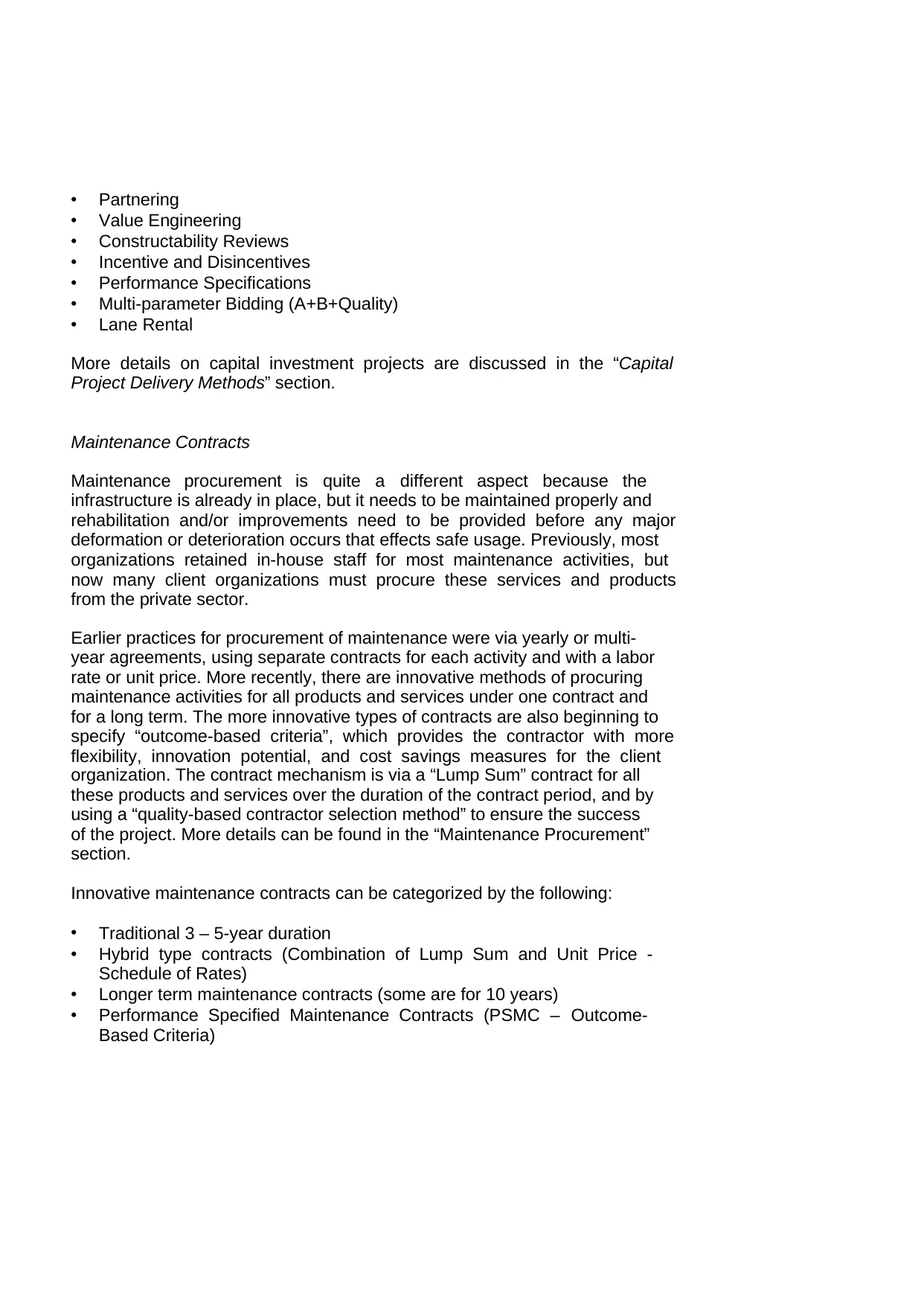
• Partnering
• Value Engineering
• Constructability Reviews
• Incentive and Disincentives
• Performance Specifications
• Multi-parameter Bidding (A+B+Quality)
• Lane Rental
More details on capital investment projects are discussed in the “Capital
Project Delivery Methods” section.
Maintenance Contracts
Maintenance procurement is quite a different aspect because the
infrastructure is already in place, but it needs to be maintained properly and
rehabilitation and/or improvements need to be provided before any major
deformation or deterioration occurs that effects safe usage. Previously, most
organizations retained in-house staff for most maintenance activities, but
now many client organizations must procure these services and products
from the private sector.
Earlier practices for procurement of maintenance were via yearly or multi-
year agreements, using separate contracts for each activity and with a labor
rate or unit price. More recently, there are innovative methods of procuring
maintenance activities for all products and services under one contract and
for a long term. The more innovative types of contracts are also beginning to
specify “outcome-based criteria”, which provides the contractor with more
flexibility, innovation potential, and cost savings measures for the client
organization. The contract mechanism is via a “Lump Sum” contract for all
these products and services over the duration of the contract period, and by
using a “quality-based contractor selection method” to ensure the success
of the project. More details can be found in the “Maintenance Procurement”
section.
Innovative maintenance contracts can be categorized by the following:
• Traditional 3 – 5-year duration
• Hybrid type contracts (Combination of Lump Sum and Unit Price -
Schedule of Rates)
• Longer term maintenance contracts (some are for 10 years)
• Performance Specified Maintenance Contracts (PSMC – Outcome-
Based Criteria)
• Value Engineering
• Constructability Reviews
• Incentive and Disincentives
• Performance Specifications
• Multi-parameter Bidding (A+B+Quality)
• Lane Rental
More details on capital investment projects are discussed in the “Capital
Project Delivery Methods” section.
Maintenance Contracts
Maintenance procurement is quite a different aspect because the
infrastructure is already in place, but it needs to be maintained properly and
rehabilitation and/or improvements need to be provided before any major
deformation or deterioration occurs that effects safe usage. Previously, most
organizations retained in-house staff for most maintenance activities, but
now many client organizations must procure these services and products
from the private sector.
Earlier practices for procurement of maintenance were via yearly or multi-
year agreements, using separate contracts for each activity and with a labor
rate or unit price. More recently, there are innovative methods of procuring
maintenance activities for all products and services under one contract and
for a long term. The more innovative types of contracts are also beginning to
specify “outcome-based criteria”, which provides the contractor with more
flexibility, innovation potential, and cost savings measures for the client
organization. The contract mechanism is via a “Lump Sum” contract for all
these products and services over the duration of the contract period, and by
using a “quality-based contractor selection method” to ensure the success
of the project. More details can be found in the “Maintenance Procurement”
section.
Innovative maintenance contracts can be categorized by the following:
• Traditional 3 – 5-year duration
• Hybrid type contracts (Combination of Lump Sum and Unit Price -
Schedule of Rates)
• Longer term maintenance contracts (some are for 10 years)
• Performance Specified Maintenance Contracts (PSMC – Outcome-
Based Criteria)
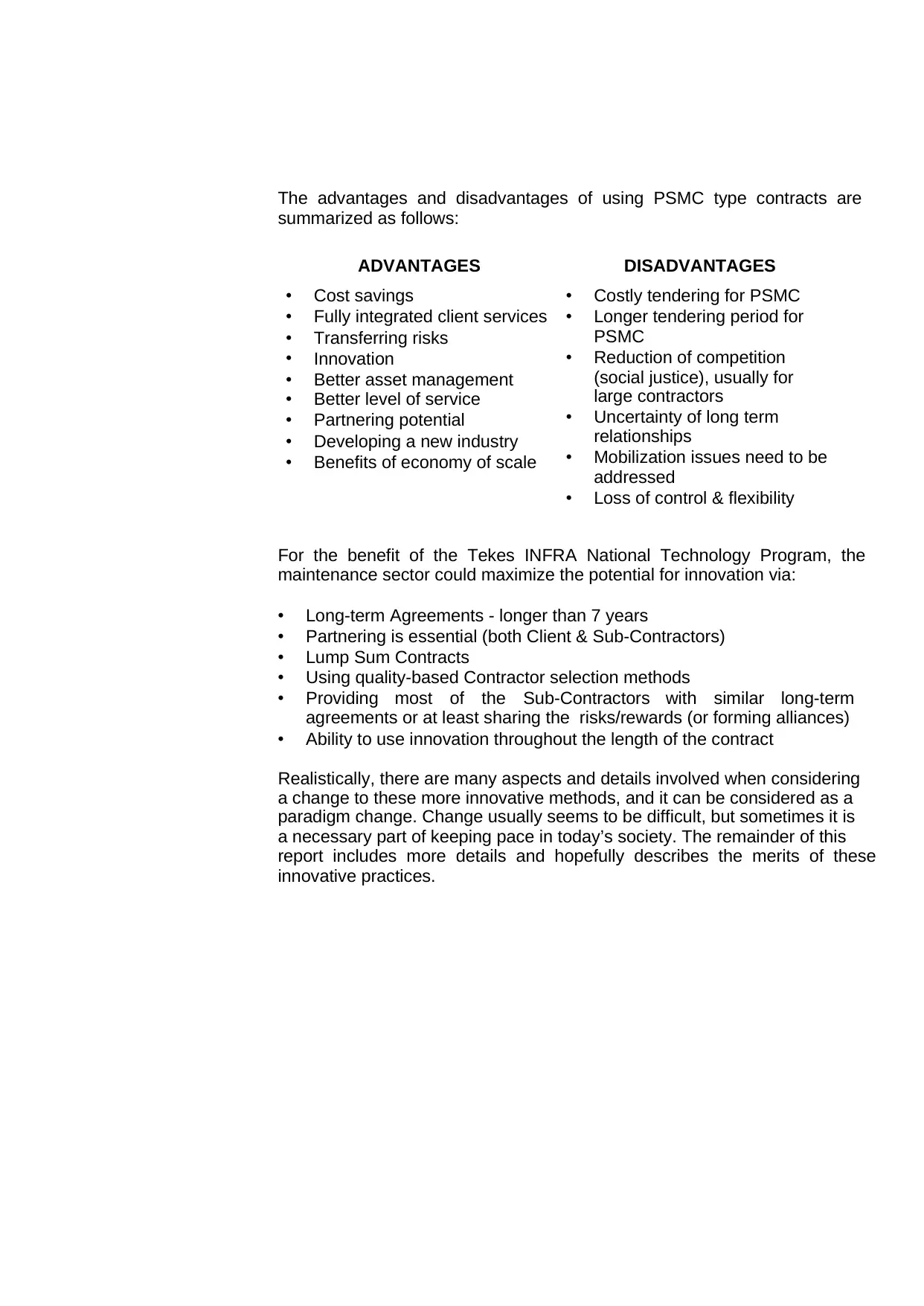
The advantages and disadvantages of using PSMC type contracts are
summarized as follows:
ADVANTAGES DISADVANTAGES
• Cost savings
• Fully integrated client services
• Transferring risks
• Innovation
• Better asset management
• Better level of service
• Partnering potential
• Developing a new industry
• Benefits of economy of scale
• Costly tendering for PSMC
• Longer tendering period for
PSMC
• Reduction of competition
(social justice), usually for
large contractors
• Uncertainty of long term
relationships
• Mobilization issues need to be
addressed
• Loss of control & flexibility
For the benefit of the Tekes INFRA National Technology Program, the
maintenance sector could maximize the potential for innovation via:
• Long-term Agreements - longer than 7 years
• Partnering is essential (both Client & Sub-Contractors)
• Lump Sum Contracts
• Using quality-based Contractor selection methods
• Providing most of the Sub-Contractors with similar long-term
agreements or at least sharing the risks/rewards (or forming alliances)
• Ability to use innovation throughout the length of the contract
Realistically, there are many aspects and details involved when considering
a change to these more innovative methods, and it can be considered as a
paradigm change. Change usually seems to be difficult, but sometimes it is
a necessary part of keeping pace in today’s society. The remainder of this
report includes more details and hopefully describes the merits of these
innovative practices.
summarized as follows:
ADVANTAGES DISADVANTAGES
• Cost savings
• Fully integrated client services
• Transferring risks
• Innovation
• Better asset management
• Better level of service
• Partnering potential
• Developing a new industry
• Benefits of economy of scale
• Costly tendering for PSMC
• Longer tendering period for
PSMC
• Reduction of competition
(social justice), usually for
large contractors
• Uncertainty of long term
relationships
• Mobilization issues need to be
addressed
• Loss of control & flexibility
For the benefit of the Tekes INFRA National Technology Program, the
maintenance sector could maximize the potential for innovation via:
• Long-term Agreements - longer than 7 years
• Partnering is essential (both Client & Sub-Contractors)
• Lump Sum Contracts
• Using quality-based Contractor selection methods
• Providing most of the Sub-Contractors with similar long-term
agreements or at least sharing the risks/rewards (or forming alliances)
• Ability to use innovation throughout the length of the contract
Realistically, there are many aspects and details involved when considering
a change to these more innovative methods, and it can be considered as a
paradigm change. Change usually seems to be difficult, but sometimes it is
a necessary part of keeping pace in today’s society. The remainder of this
report includes more details and hopefully describes the merits of these
innovative practices.
⊘ This is a preview!⊘
Do you want full access?
Subscribe today to unlock all pages.

Trusted by 1+ million students worldwide
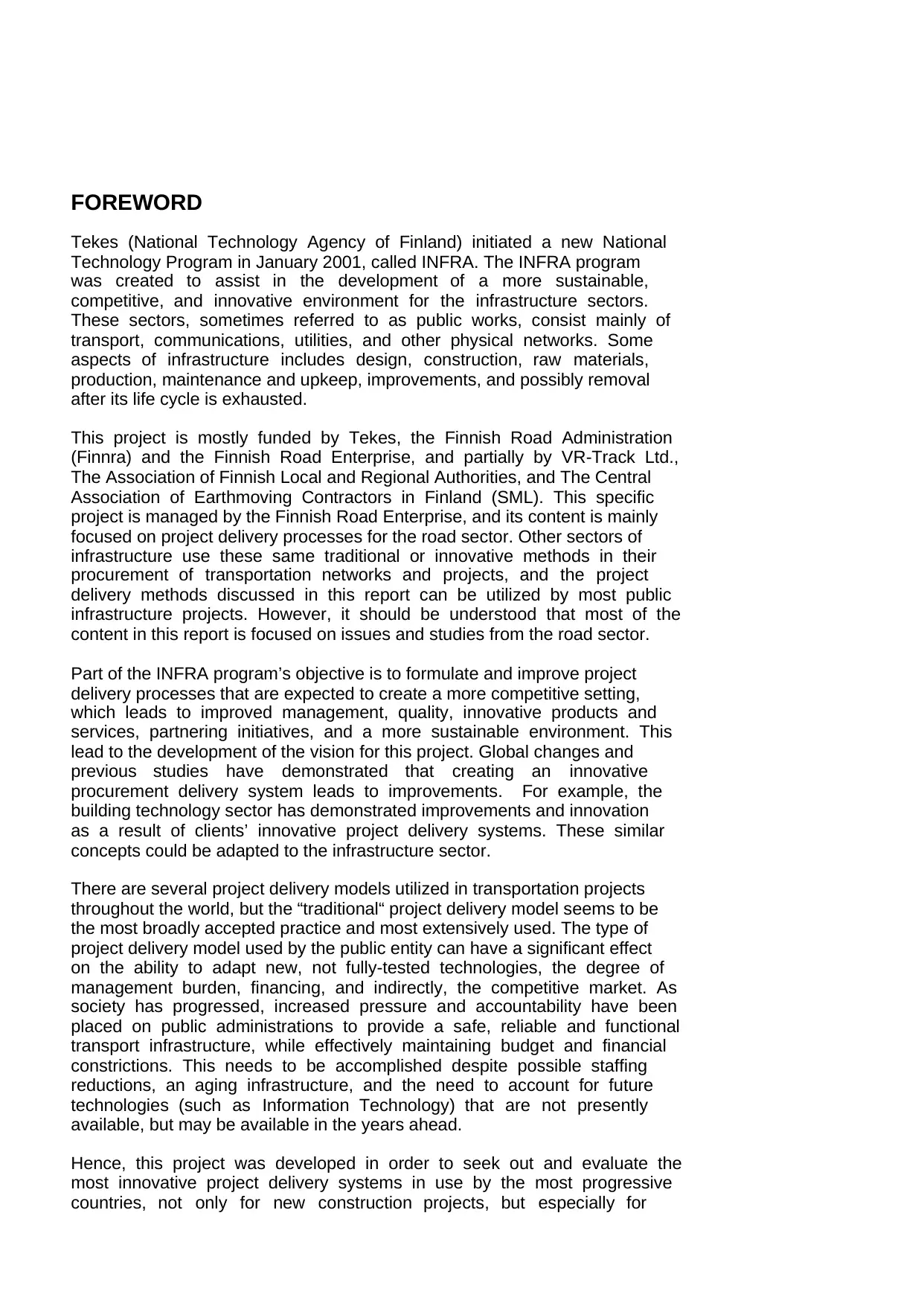
FOREWORD
Tekes (National Technology Agency of Finland) initiated a new National
Technology Program in January 2001, called INFRA. The INFRA program
was created to assist in the development of a more sustainable,
competitive, and innovative environment for the infrastructure sectors.
These sectors, sometimes referred to as public works, consist mainly of
transport, communications, utilities, and other physical networks. Some
aspects of infrastructure includes design, construction, raw materials,
production, maintenance and upkeep, improvements, and possibly removal
after its life cycle is exhausted.
This project is mostly funded by Tekes, the Finnish Road Administration
(Finnra) and the Finnish Road Enterprise, and partially by VR-Track Ltd.,
The Association of Finnish Local and Regional Authorities, and The Central
Association of Earthmoving Contractors in Finland (SML). This specific
project is managed by the Finnish Road Enterprise, and its content is mainly
focused on project delivery processes for the road sector. Other sectors of
infrastructure use these same traditional or innovative methods in their
procurement of transportation networks and projects, and the project
delivery methods discussed in this report can be utilized by most public
infrastructure projects. However, it should be understood that most of the
content in this report is focused on issues and studies from the road sector.
Part of the INFRA program’s objective is to formulate and improve project
delivery processes that are expected to create a more competitive setting,
which leads to improved management, quality, innovative products and
services, partnering initiatives, and a more sustainable environment. This
lead to the development of the vision for this project. Global changes and
previous studies have demonstrated that creating an innovative
procurement delivery system leads to improvements. For example, the
building technology sector has demonstrated improvements and innovation
as a result of clients’ innovative project delivery systems. These similar
concepts could be adapted to the infrastructure sector.
There are several project delivery models utilized in transportation projects
throughout the world, but the “traditional“ project delivery model seems to be
the most broadly accepted practice and most extensively used. The type of
project delivery model used by the public entity can have a significant effect
on the ability to adapt new, not fully-tested technologies, the degree of
management burden, financing, and indirectly, the competitive market. As
society has progressed, increased pressure and accountability have been
placed on public administrations to provide a safe, reliable and functional
transport infrastructure, while effectively maintaining budget and financial
constrictions. This needs to be accomplished despite possible staffing
reductions, an aging infrastructure, and the need to account for future
technologies (such as Information Technology) that are not presently
available, but may be available in the years ahead.
Hence, this project was developed in order to seek out and evaluate the
most innovative project delivery systems in use by the most progressive
countries, not only for new construction projects, but especially for
Tekes (National Technology Agency of Finland) initiated a new National
Technology Program in January 2001, called INFRA. The INFRA program
was created to assist in the development of a more sustainable,
competitive, and innovative environment for the infrastructure sectors.
These sectors, sometimes referred to as public works, consist mainly of
transport, communications, utilities, and other physical networks. Some
aspects of infrastructure includes design, construction, raw materials,
production, maintenance and upkeep, improvements, and possibly removal
after its life cycle is exhausted.
This project is mostly funded by Tekes, the Finnish Road Administration
(Finnra) and the Finnish Road Enterprise, and partially by VR-Track Ltd.,
The Association of Finnish Local and Regional Authorities, and The Central
Association of Earthmoving Contractors in Finland (SML). This specific
project is managed by the Finnish Road Enterprise, and its content is mainly
focused on project delivery processes for the road sector. Other sectors of
infrastructure use these same traditional or innovative methods in their
procurement of transportation networks and projects, and the project
delivery methods discussed in this report can be utilized by most public
infrastructure projects. However, it should be understood that most of the
content in this report is focused on issues and studies from the road sector.
Part of the INFRA program’s objective is to formulate and improve project
delivery processes that are expected to create a more competitive setting,
which leads to improved management, quality, innovative products and
services, partnering initiatives, and a more sustainable environment. This
lead to the development of the vision for this project. Global changes and
previous studies have demonstrated that creating an innovative
procurement delivery system leads to improvements. For example, the
building technology sector has demonstrated improvements and innovation
as a result of clients’ innovative project delivery systems. These similar
concepts could be adapted to the infrastructure sector.
There are several project delivery models utilized in transportation projects
throughout the world, but the “traditional“ project delivery model seems to be
the most broadly accepted practice and most extensively used. The type of
project delivery model used by the public entity can have a significant effect
on the ability to adapt new, not fully-tested technologies, the degree of
management burden, financing, and indirectly, the competitive market. As
society has progressed, increased pressure and accountability have been
placed on public administrations to provide a safe, reliable and functional
transport infrastructure, while effectively maintaining budget and financial
constrictions. This needs to be accomplished despite possible staffing
reductions, an aging infrastructure, and the need to account for future
technologies (such as Information Technology) that are not presently
available, but may be available in the years ahead.
Hence, this project was developed in order to seek out and evaluate the
most innovative project delivery systems in use by the most progressive
countries, not only for new construction projects, but especially for
Paraphrase This Document
Need a fresh take? Get an instant paraphrase of this document with our AI Paraphraser
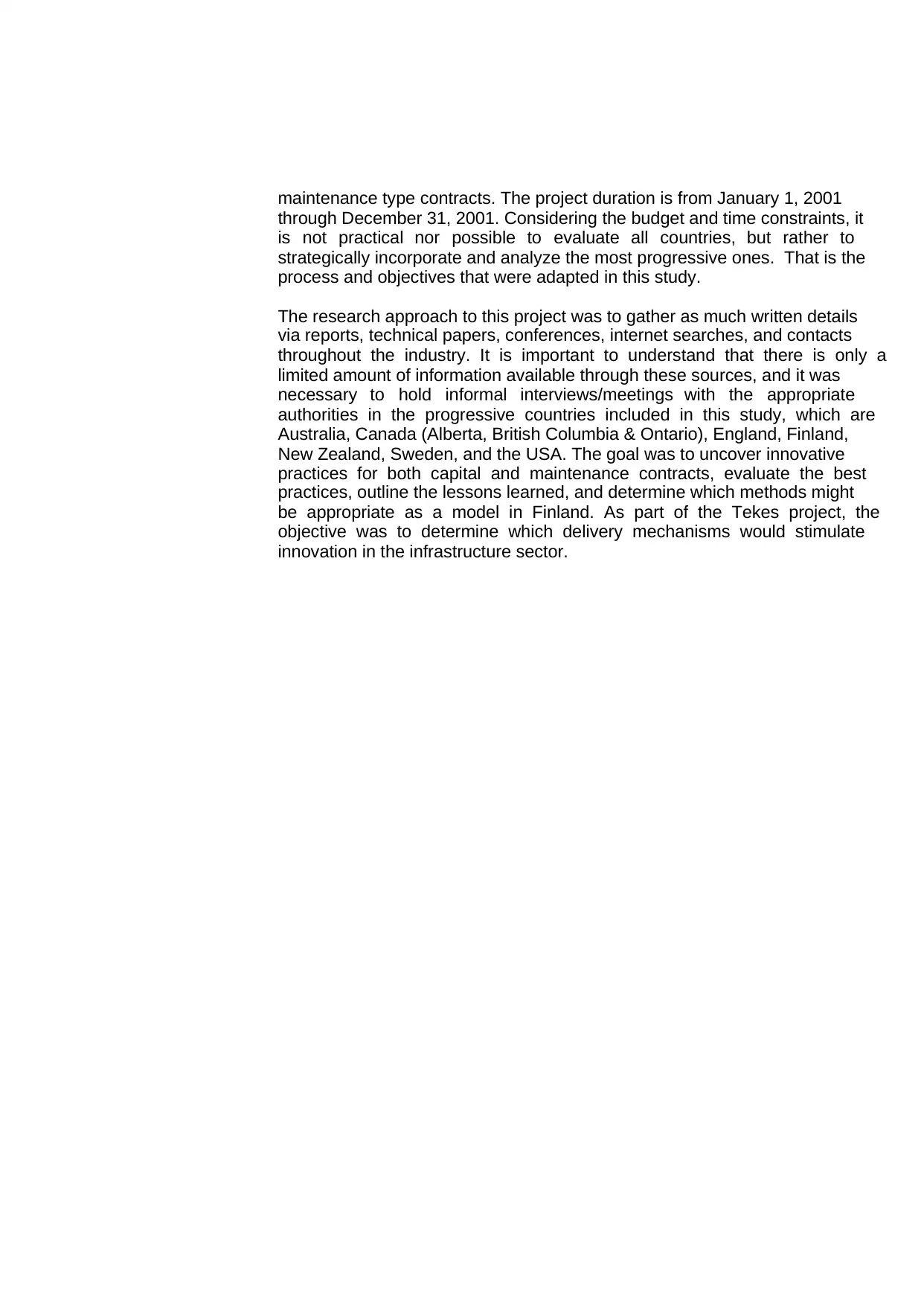
maintenance type contracts. The project duration is from January 1, 2001
through December 31, 2001. Considering the budget and time constraints, it
is not practical nor possible to evaluate all countries, but rather to
strategically incorporate and analyze the most progressive ones. That is the
process and objectives that were adapted in this study.
The research approach to this project was to gather as much written details
via reports, technical papers, conferences, internet searches, and contacts
throughout the industry. It is important to understand that there is only a
limited amount of information available through these sources, and it was
necessary to hold informal interviews/meetings with the appropriate
authorities in the progressive countries included in this study, which are
Australia, Canada (Alberta, British Columbia & Ontario), England, Finland,
New Zealand, Sweden, and the USA. The goal was to uncover innovative
practices for both capital and maintenance contracts, evaluate the best
practices, outline the lessons learned, and determine which methods might
be appropriate as a model in Finland. As part of the Tekes project, the
objective was to determine which delivery mechanisms would stimulate
innovation in the infrastructure sector.
through December 31, 2001. Considering the budget and time constraints, it
is not practical nor possible to evaluate all countries, but rather to
strategically incorporate and analyze the most progressive ones. That is the
process and objectives that were adapted in this study.
The research approach to this project was to gather as much written details
via reports, technical papers, conferences, internet searches, and contacts
throughout the industry. It is important to understand that there is only a
limited amount of information available through these sources, and it was
necessary to hold informal interviews/meetings with the appropriate
authorities in the progressive countries included in this study, which are
Australia, Canada (Alberta, British Columbia & Ontario), England, Finland,
New Zealand, Sweden, and the USA. The goal was to uncover innovative
practices for both capital and maintenance contracts, evaluate the best
practices, outline the lessons learned, and determine which methods might
be appropriate as a model in Finland. As part of the Tekes project, the
objective was to determine which delivery mechanisms would stimulate
innovation in the infrastructure sector.
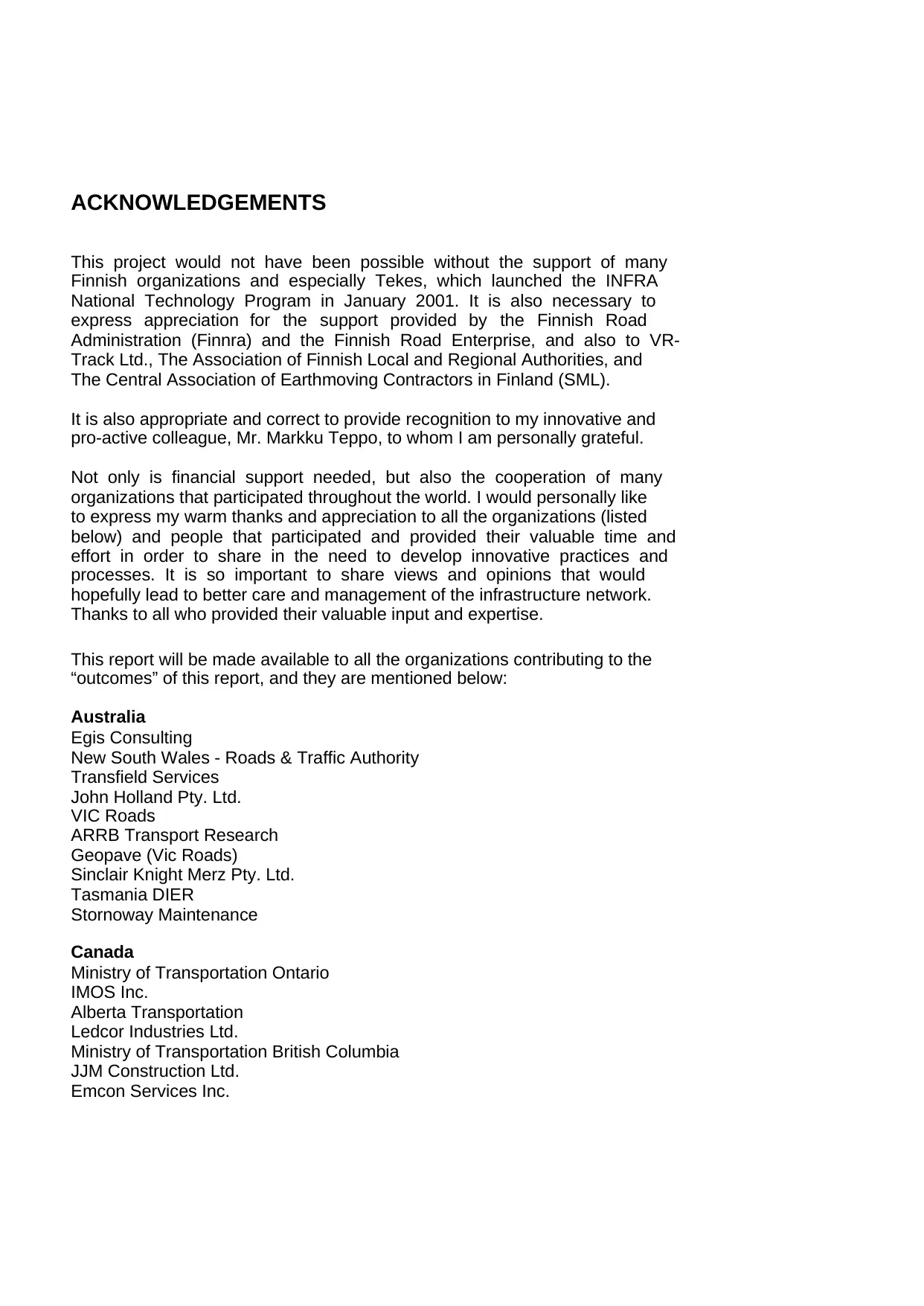
ACKNOWLEDGEMENTS
This project would not have been possible without the support of many
Finnish organizations and especially Tekes, which launched the INFRA
National Technology Program in January 2001. It is also necessary to
express appreciation for the support provided by the Finnish Road
Administration (Finnra) and the Finnish Road Enterprise, and also to VR-
Track Ltd., The Association of Finnish Local and Regional Authorities, and
The Central Association of Earthmoving Contractors in Finland (SML).
It is also appropriate and correct to provide recognition to my innovative and
pro-active colleague, Mr. Markku Teppo, to whom I am personally grateful.
Not only is financial support needed, but also the cooperation of many
organizations that participated throughout the world. I would personally like
to express my warm thanks and appreciation to all the organizations (listed
below) and people that participated and provided their valuable time and
effort in order to share in the need to develop innovative practices and
processes. It is so important to share views and opinions that would
hopefully lead to better care and management of the infrastructure network.
Thanks to all who provided their valuable input and expertise.
This report will be made available to all the organizations contributing to the
“outcomes” of this report, and they are mentioned below:
Australia
Egis Consulting
New South Wales - Roads & Traffic Authority
Transfield Services
John Holland Pty. Ltd.
VIC Roads
ARRB Transport Research
Geopave (Vic Roads)
Sinclair Knight Merz Pty. Ltd.
Tasmania DIER
Stornoway Maintenance
Canada
Ministry of Transportation Ontario
IMOS Inc.
Alberta Transportation
Ledcor Industries Ltd.
Ministry of Transportation British Columbia
JJM Construction Ltd.
Emcon Services Inc.
This project would not have been possible without the support of many
Finnish organizations and especially Tekes, which launched the INFRA
National Technology Program in January 2001. It is also necessary to
express appreciation for the support provided by the Finnish Road
Administration (Finnra) and the Finnish Road Enterprise, and also to VR-
Track Ltd., The Association of Finnish Local and Regional Authorities, and
The Central Association of Earthmoving Contractors in Finland (SML).
It is also appropriate and correct to provide recognition to my innovative and
pro-active colleague, Mr. Markku Teppo, to whom I am personally grateful.
Not only is financial support needed, but also the cooperation of many
organizations that participated throughout the world. I would personally like
to express my warm thanks and appreciation to all the organizations (listed
below) and people that participated and provided their valuable time and
effort in order to share in the need to develop innovative practices and
processes. It is so important to share views and opinions that would
hopefully lead to better care and management of the infrastructure network.
Thanks to all who provided their valuable input and expertise.
This report will be made available to all the organizations contributing to the
“outcomes” of this report, and they are mentioned below:
Australia
Egis Consulting
New South Wales - Roads & Traffic Authority
Transfield Services
John Holland Pty. Ltd.
VIC Roads
ARRB Transport Research
Geopave (Vic Roads)
Sinclair Knight Merz Pty. Ltd.
Tasmania DIER
Stornoway Maintenance
Canada
Ministry of Transportation Ontario
IMOS Inc.
Alberta Transportation
Ledcor Industries Ltd.
Ministry of Transportation British Columbia
JJM Construction Ltd.
Emcon Services Inc.
⊘ This is a preview!⊘
Do you want full access?
Subscribe today to unlock all pages.

Trusted by 1+ million students worldwide
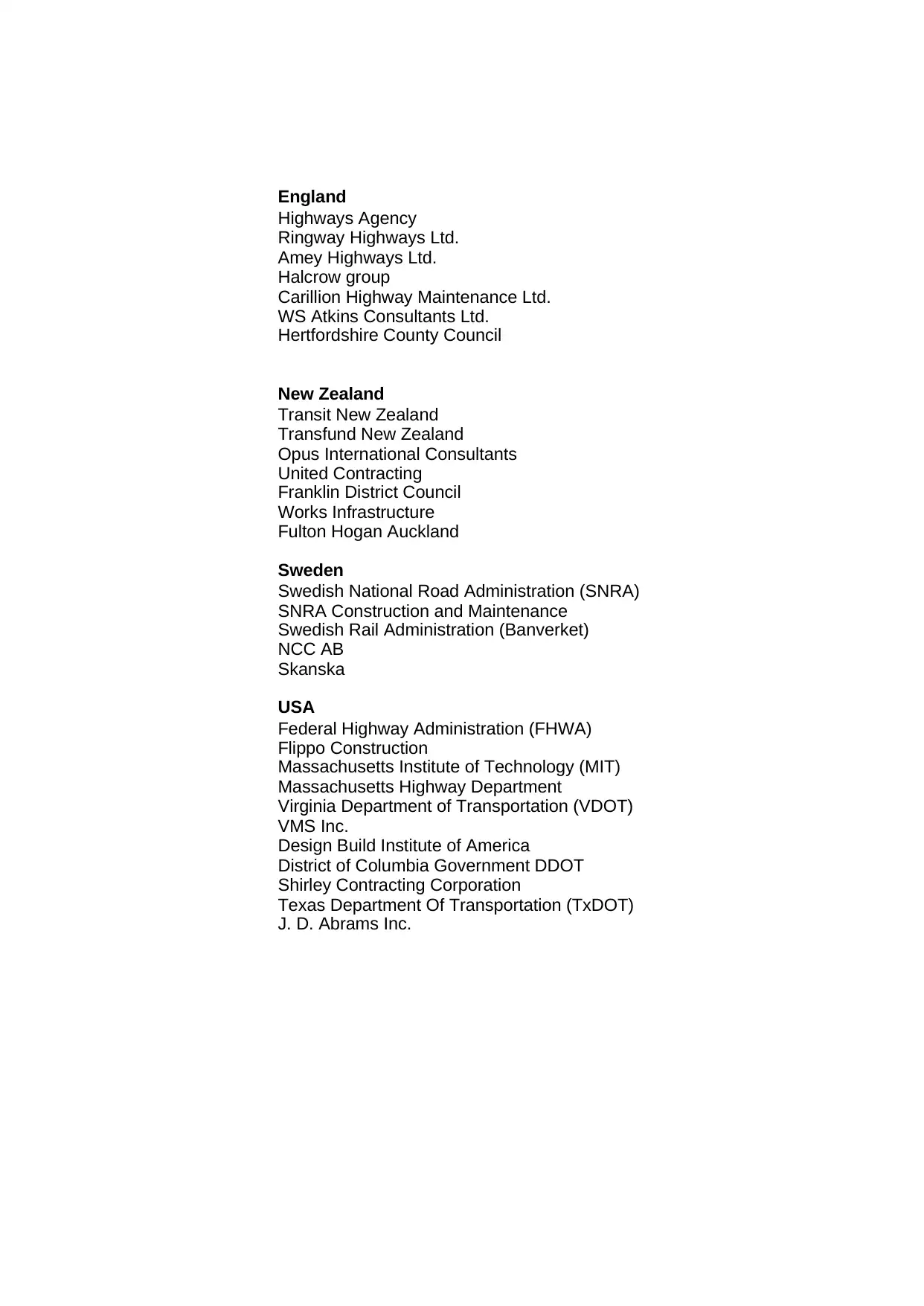
England
Highways Agency
Ringway Highways Ltd.
Amey Highways Ltd.
Halcrow group
Carillion Highway Maintenance Ltd.
WS Atkins Consultants Ltd.
Hertfordshire County Council
New Zealand
Transit New Zealand
Transfund New Zealand
Opus International Consultants
United Contracting
Franklin District Council
Works Infrastructure
Fulton Hogan Auckland
Sweden
Swedish National Road Administration (SNRA)
SNRA Construction and Maintenance
Swedish Rail Administration (Banverket)
NCC AB
Skanska
USA
Federal Highway Administration (FHWA)
Flippo Construction
Massachusetts Institute of Technology (MIT)
Massachusetts Highway Department
Virginia Department of Transportation (VDOT)
VMS Inc.
Design Build Institute of America
District of Columbia Government DDOT
Shirley Contracting Corporation
Texas Department Of Transportation (TxDOT)
J. D. Abrams Inc.
Highways Agency
Ringway Highways Ltd.
Amey Highways Ltd.
Halcrow group
Carillion Highway Maintenance Ltd.
WS Atkins Consultants Ltd.
Hertfordshire County Council
New Zealand
Transit New Zealand
Transfund New Zealand
Opus International Consultants
United Contracting
Franklin District Council
Works Infrastructure
Fulton Hogan Auckland
Sweden
Swedish National Road Administration (SNRA)
SNRA Construction and Maintenance
Swedish Rail Administration (Banverket)
NCC AB
Skanska
USA
Federal Highway Administration (FHWA)
Flippo Construction
Massachusetts Institute of Technology (MIT)
Massachusetts Highway Department
Virginia Department of Transportation (VDOT)
VMS Inc.
Design Build Institute of America
District of Columbia Government DDOT
Shirley Contracting Corporation
Texas Department Of Transportation (TxDOT)
J. D. Abrams Inc.
Paraphrase This Document
Need a fresh take? Get an instant paraphrase of this document with our AI Paraphraser
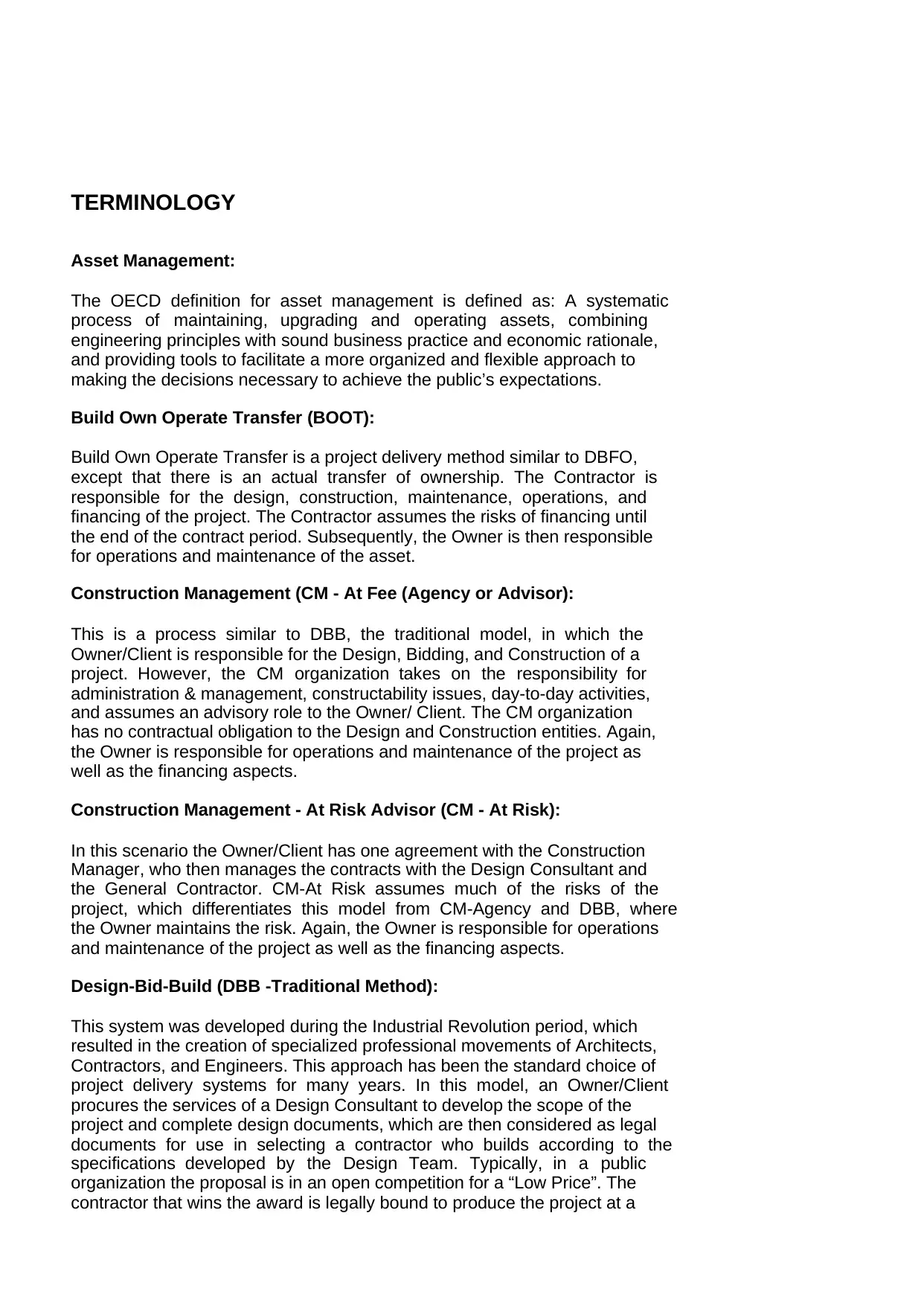
TERMINOLOGY
Asset Management:
The OECD definition for asset management is defined as: A systematic
process of maintaining, upgrading and operating assets, combining
engineering principles with sound business practice and economic rationale,
and providing tools to facilitate a more organized and flexible approach to
making the decisions necessary to achieve the public’s expectations.
Build Own Operate Transfer (BOOT):
Build Own Operate Transfer is a project delivery method similar to DBFO,
except that there is an actual transfer of ownership. The Contractor is
responsible for the design, construction, maintenance, operations, and
financing of the project. The Contractor assumes the risks of financing until
the end of the contract period. Subsequently, the Owner is then responsible
for operations and maintenance of the asset.
Construction Management (CM - At Fee (Agency or Advisor):
This is a process similar to DBB, the traditional model, in which the
Owner/Client is responsible for the Design, Bidding, and Construction of a
project. However, the CM organization takes on the responsibility for
administration & management, constructability issues, day-to-day activities,
and assumes an advisory role to the Owner/ Client. The CM organization
has no contractual obligation to the Design and Construction entities. Again,
the Owner is responsible for operations and maintenance of the project as
well as the financing aspects.
Construction Management - At Risk Advisor (CM - At Risk):
In this scenario the Owner/Client has one agreement with the Construction
Manager, who then manages the contracts with the Design Consultant and
the General Contractor. CM-At Risk assumes much of the risks of the
project, which differentiates this model from CM-Agency and DBB, where
the Owner maintains the risk. Again, the Owner is responsible for operations
and maintenance of the project as well as the financing aspects.
Design-Bid-Build (DBB -Traditional Method):
This system was developed during the Industrial Revolution period, which
resulted in the creation of specialized professional movements of Architects,
Contractors, and Engineers. This approach has been the standard choice of
project delivery systems for many years. In this model, an Owner/Client
procures the services of a Design Consultant to develop the scope of the
project and complete design documents, which are then considered as legal
documents for use in selecting a contractor who builds according to the
specifications developed by the Design Team. Typically, in a public
organization the proposal is in an open competition for a “Low Price”. The
contractor that wins the award is legally bound to produce the project at a
Asset Management:
The OECD definition for asset management is defined as: A systematic
process of maintaining, upgrading and operating assets, combining
engineering principles with sound business practice and economic rationale,
and providing tools to facilitate a more organized and flexible approach to
making the decisions necessary to achieve the public’s expectations.
Build Own Operate Transfer (BOOT):
Build Own Operate Transfer is a project delivery method similar to DBFO,
except that there is an actual transfer of ownership. The Contractor is
responsible for the design, construction, maintenance, operations, and
financing of the project. The Contractor assumes the risks of financing until
the end of the contract period. Subsequently, the Owner is then responsible
for operations and maintenance of the asset.
Construction Management (CM - At Fee (Agency or Advisor):
This is a process similar to DBB, the traditional model, in which the
Owner/Client is responsible for the Design, Bidding, and Construction of a
project. However, the CM organization takes on the responsibility for
administration & management, constructability issues, day-to-day activities,
and assumes an advisory role to the Owner/ Client. The CM organization
has no contractual obligation to the Design and Construction entities. Again,
the Owner is responsible for operations and maintenance of the project as
well as the financing aspects.
Construction Management - At Risk Advisor (CM - At Risk):
In this scenario the Owner/Client has one agreement with the Construction
Manager, who then manages the contracts with the Design Consultant and
the General Contractor. CM-At Risk assumes much of the risks of the
project, which differentiates this model from CM-Agency and DBB, where
the Owner maintains the risk. Again, the Owner is responsible for operations
and maintenance of the project as well as the financing aspects.
Design-Bid-Build (DBB -Traditional Method):
This system was developed during the Industrial Revolution period, which
resulted in the creation of specialized professional movements of Architects,
Contractors, and Engineers. This approach has been the standard choice of
project delivery systems for many years. In this model, an Owner/Client
procures the services of a Design Consultant to develop the scope of the
project and complete design documents, which are then considered as legal
documents for use in selecting a contractor who builds according to the
specifications developed by the Design Team. Typically, in a public
organization the proposal is in an open competition for a “Low Price”. The
contractor that wins the award is legally bound to produce the project at a

certain price, schedule, and minimum level of standard care. After
completion of the project, the Owner is then responsible for operations and
maintenance of the project. The Owner is also responsible for all the
financing aspects.
Design-Build (DB):
This system heritage is as old as the days during the construction of the
pyramids, when it was referred to with the term Master Builder. Design-Build
is simply a project delivery method in which the Owner/Client selects an
organization that will complete both the design and construction under one
agreement. Upon completion, the Owner is then responsible for operations
and maintenance of the project. The Owner is also responsible for all the
financing aspects.
Design-Build-Operate-Maintain (DBOM):
Design-Build-Operate-Maintain is a project delivery method in which the
Owner/Client selects an organization that will complete the design,
construction, maintenance and an agreed upon period of operational
parameters under one agreement. Upon termination of the operational
period, the Owner is then responsible for operations and maintenance of the
project, unless the operations are continued under a separate procurement
method.
Design-Build/Finance/Operate (DBFO):
Design-Build/Finance/Operate is a project delivery method similar to DBOM,
except that the Contractor is also responsible for the financing of the project.
The contractor assumes the risks of financing until the end of the contract
period. The Owner is then responsible for operations and maintenance of
the asset.
Fully Integrated Clients Services:
“Fully Integrated Clients Services” in this report refers to most, if not all
maintenance activities, that are procured under one contract. In other
words, one contract that includes all the maintenance products and
services.
Lump Sum:
Lump Sum is considered as a fixed price agreement for the total work and
products of a given project. Sometimes this is also referred to as a “Fixed
Price” contract. Any changes to the contract must be agreed upon by both
parties, and they are usually described under “Change Orders”.
Network Area:
A Network Area is defined as a certain geographical area that includes all
the road assets, usually stated in terms of kilometers of roads. It also
includes other assets such as signs, guard rails, etc.
completion of the project, the Owner is then responsible for operations and
maintenance of the project. The Owner is also responsible for all the
financing aspects.
Design-Build (DB):
This system heritage is as old as the days during the construction of the
pyramids, when it was referred to with the term Master Builder. Design-Build
is simply a project delivery method in which the Owner/Client selects an
organization that will complete both the design and construction under one
agreement. Upon completion, the Owner is then responsible for operations
and maintenance of the project. The Owner is also responsible for all the
financing aspects.
Design-Build-Operate-Maintain (DBOM):
Design-Build-Operate-Maintain is a project delivery method in which the
Owner/Client selects an organization that will complete the design,
construction, maintenance and an agreed upon period of operational
parameters under one agreement. Upon termination of the operational
period, the Owner is then responsible for operations and maintenance of the
project, unless the operations are continued under a separate procurement
method.
Design-Build/Finance/Operate (DBFO):
Design-Build/Finance/Operate is a project delivery method similar to DBOM,
except that the Contractor is also responsible for the financing of the project.
The contractor assumes the risks of financing until the end of the contract
period. The Owner is then responsible for operations and maintenance of
the asset.
Fully Integrated Clients Services:
“Fully Integrated Clients Services” in this report refers to most, if not all
maintenance activities, that are procured under one contract. In other
words, one contract that includes all the maintenance products and
services.
Lump Sum:
Lump Sum is considered as a fixed price agreement for the total work and
products of a given project. Sometimes this is also referred to as a “Fixed
Price” contract. Any changes to the contract must be agreed upon by both
parties, and they are usually described under “Change Orders”.
Network Area:
A Network Area is defined as a certain geographical area that includes all
the road assets, usually stated in terms of kilometers of roads. It also
includes other assets such as signs, guard rails, etc.
⊘ This is a preview!⊘
Do you want full access?
Subscribe today to unlock all pages.

Trusted by 1+ million students worldwide
1 out of 122
Your All-in-One AI-Powered Toolkit for Academic Success.
+13062052269
info@desklib.com
Available 24*7 on WhatsApp / Email
![[object Object]](/_next/static/media/star-bottom.7253800d.svg)
Unlock your academic potential
Copyright © 2020–2025 A2Z Services. All Rights Reserved. Developed and managed by ZUCOL.